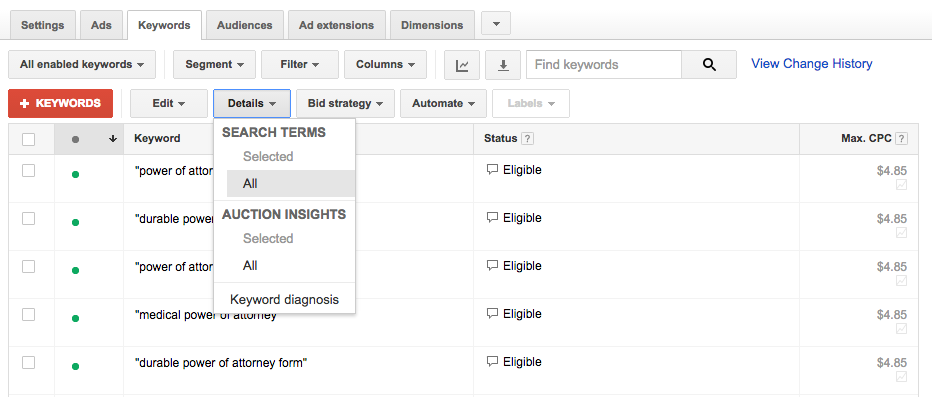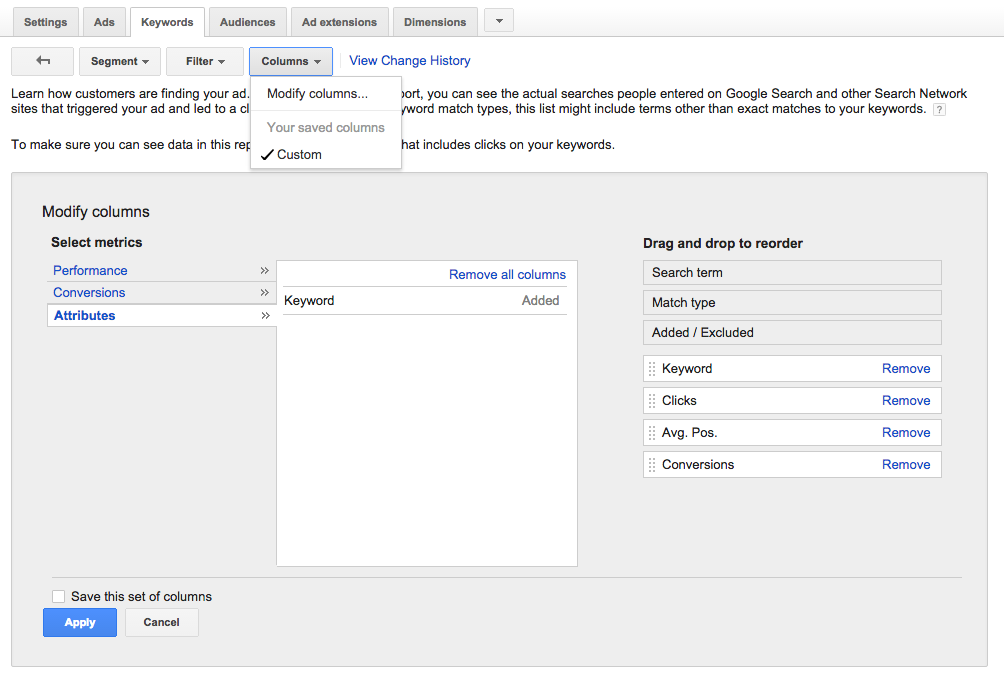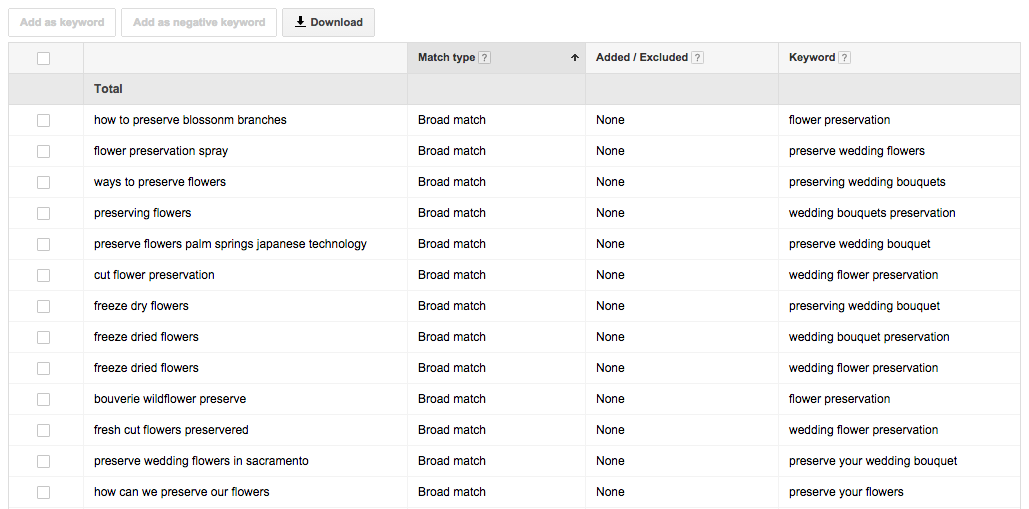Setting up an AdWords campaign is easy.
Google built a painless onboarding process that walks you through each step. You create a campaign, add ad groups, write your ads, do a little keyword research, and you’re ready to start advertising. The campaigns are even enabled by default so your ads start running right away.
After you’re set up, you’ll check your ads and they look great.
Perfect! Let’s make some money!
The next morning you take another look and you don’t see your ads. It’s only 10:00 am. You’re thinking: “Why aren’t my ads running?” After a quick investigation, you see that your entire budget has already been used.
How has your budget been used before you even hit lunch?
You might be thinking: “Google is a complete waste of money!”
It can be if you’re not careful.
Where did my money go?
If you followed the standard onboarding process and are not familiar with AdWords, you likely didn’t know about the different keyword match types that are available.
When a Google user searches for something, Google looks at that search phrase and shows ads that are relevant to the user’s search. When Google is deciding which ads to show, it uses a matching algorithm to match your keywords with the search phrase that’s been entered.
You can specify different matching rules for Google to help ensure ads are shown to the right people.
These are called match types are there are five variations.
- Broad match
- Broad match modifier
- Phrase match
- Exact match
- Negative match
Google has an explainer page of each match type here.
Broad match is the most liberal and they become more restrictive with exact and negative match. By default, all keywords you add to AdWords are broad match. This means your ad is shown a lot and likely shown to the wrong people.
Broad match can kill your budget and normally result in very poor performance.
Why is broad match dangerous?
When setting up your keywords as broad match, you have very little control over who’s seeing your ads.
We’ll use an example from a client.
One of our clients sells wedding bouquet preservation services. When your wedding is over, you give them the flowers and they preserve them in display pieces.
When adding keywords for this client, an obvious keyword is “wedding flower preservation.”
However, if this keyword is set to broad match, anyone searching for “wedding flowers” may match against “wedding flower preservation.” The ad will show to a consumer researching wedding flowers, that user might click the ad, you’re charged for the click and your budget begins dropping.
Some might argue that the visitor looking for wedding flowers may eventually want preservation services. That might be true, but we’re generally looking for the consumers who are ready to buy, take action and move through the buying funnel. Focused AdWords marketing is incredibly important to stretch your dollars as far as possible.
If we were to change the match type of the “wedding flower preservation” keyword to phrase match, the ad only shows if that phrase is part of their search.
The ad wouldn’t show for “wedding flowers” but it would show for “wedding flower preservation in phoenix” or “best wedding flower preservation companies”.
How to review your keyword matches
If you’re not sure what search phrases are triggering what keywords, you can review these matches in your AdWords account. You can also see what matching method is being used for each search.
Step 1: Go to your keywords tab and view “Details -> Search Terms -> All”
Step 2: Modify your columns so you can see the keyword that matched against each search term
Step 3: Review the keyword searched by the visitor, match type and keyword it matched
As you can see in this example, most of the visitor searches were Phrase matches against “power of attorney” and “medical power of attorney.” Some searches were exact which means that the Google user searched the exact keyword we selected for our campaign. This means that we targeted this user specifically.
Example of broad matching
In the flower preservation instance we mentioned above, we started the campaign with broad search terms to see what kind of traffic people were searching for. We’ll sometimes start with broad search terms for a few weeks and then adjust all the keywords to Broad match modifier, Phrase match and exact.
In the following example, you can see that visitors were looking for all kinds of things like a “flower preservation spray” and a Japanese technology to preserve flowers. These are the type of searches we want to avoid with our matching.
Broad matching isn’t always horrible. You’ll see that some searches like “preserve wedding flowers in Sacramento” are appropriate for the campaign, but many of the others are incredibly generic and slightly off target.
Negative keywords
Regardless of your match types, there will undoubtedly be search terms that aren’t relevant to the service or product you’re selling. Negative keywords are used to prevent these terms from triggering your ads.
The terms are often things like unexpected keyword variations or people searching for jobs in your field. In the example above, “bouverie wildflower preserve” is a very unexpected variation of “flower preservation.” Adding “bouverie” as a negative keyword will prevent your ad from showing when people search for that preserve.
When you first start a campaign, it’s ideal to look at your keyword matches a few times a week at least for a few months. Adding negative keywords will slowly refine your audience, improve your quality score and optimize your campaign.
Mind your match types
AdWords defaults keyword matching to Broad match because it’s the easiest and has the most reach. Unfortunately, this match type can eat up your daily budget extremely quickly if you’re not careful.
If you have broad match terms, make sure they’re generating the right type of traffic by reviewing your keyword matches.
Related Posts
- What Is The Difference Between PPC and SEM?
- PC Audit Handbook: How to Analyze Your PPC Campaigns
- The Best PPC Tools of 2022, As Told by PPC Experts
- Beginner’s Guide to UTM Tags & Tracking
- Generate Leads with Facebook Lead Ads
- Cost-per-click vs. cost-per-acquisition: Are you tracking the right PPC metrics?
- How Does Pay Per Click Work?
- Benefits of PPC
- Why Should I Invest in PPC?
- What is Google PPC Advertising?
- Facebook Retargeting Strategy
- Introduction to ManyChat
- Case Study: Return on Ad Spend Optimization
- 🎁🎄 Holiday Ad Spend Strategy
- Should You Be Running Branded Ads?
- SEO vs SEM
- CTAs for YouTube Ads
- Case Study: 258% Increase in Conversions
- Traffic Campaign Strategy
- No Captions on Facebook Ads or YouTube? You’re Killing Performance
- LinkedIn InMail Website Re-targeting








